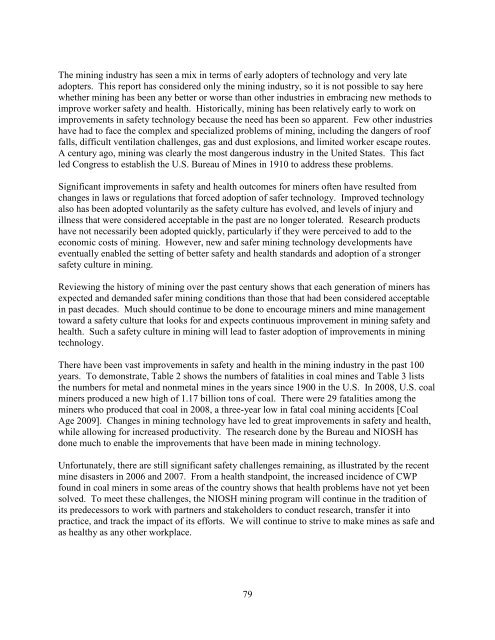One Hundred Years of Federal Mining Safety and Health Research
One Hundred Years of Federal Mining Safety and Health Research
One Hundred Years of Federal Mining Safety and Health Research
- No tags were found...
You also want an ePaper? Increase the reach of your titles
YUMPU automatically turns print PDFs into web optimized ePapers that Google loves.
The mining industry has seen a mix in terms <strong>of</strong> early adopters <strong>of</strong> technology <strong>and</strong> very late<br />
adopters. This report has considered only the mining industry, so it is not possible to say here<br />
whether mining has been any better or worse than other industries in embracing new methods to<br />
improve worker safety <strong>and</strong> health. Historically, mining has been relatively early to work on<br />
improvements in safety technology because the need has been so apparent. Few other industries<br />
have had to face the complex <strong>and</strong> specialized problems <strong>of</strong> mining, including the dangers <strong>of</strong> ro<strong>of</strong><br />
falls, difficult ventilation challenges, gas <strong>and</strong> dust explosions, <strong>and</strong> limited worker escape routes.<br />
A century ago, mining was clearly the most dangerous industry in the United States. This fact<br />
led Congress to establish the U.S. Bureau <strong>of</strong> Mines in 1910 to address these problems.<br />
Significant improvements in safety <strong>and</strong> health outcomes for miners <strong>of</strong>ten have resulted from<br />
changes in laws or regulations that forced adoption <strong>of</strong> safer technology. Improved technology<br />
also has been adopted voluntarily as the safety culture has evolved, <strong>and</strong> levels <strong>of</strong> injury <strong>and</strong><br />
illness that were considered acceptable in the past are no longer tolerated. <strong>Research</strong> products<br />
have not necessarily been adopted quickly, particularly if they were perceived to add to the<br />
economic costs <strong>of</strong> mining. However, new <strong>and</strong> safer mining technology developments have<br />
eventually enabled the setting <strong>of</strong> better safety <strong>and</strong> health st<strong>and</strong>ards <strong>and</strong> adoption <strong>of</strong> a stronger<br />
safety culture in mining.<br />
Reviewing the history <strong>of</strong> mining over the past century shows that each generation <strong>of</strong> miners has<br />
expected <strong>and</strong> dem<strong>and</strong>ed safer mining conditions than those that had been considered acceptable<br />
in past decades. Much should continue to be done to encourage miners <strong>and</strong> mine management<br />
toward a safety culture that looks for <strong>and</strong> expects continuous improvement in mining safety <strong>and</strong><br />
health. Such a safety culture in mining will lead to faster adoption <strong>of</strong> improvements in mining<br />
technology.<br />
There have been vast improvements in safety <strong>and</strong> health in the mining industry in the past 100<br />
years. To demonstrate, Table 2 shows the numbers <strong>of</strong> fatalities in coal mines <strong>and</strong> Table 3 lists<br />
the numbers for metal <strong>and</strong> nonmetal mines in the years since 1900 in the U.S. In 2008, U.S. coal<br />
miners produced a new high <strong>of</strong> 1.17 billion tons <strong>of</strong> coal. There were 29 fatalities among the<br />
miners who produced that coal in 2008, a three-year low in fatal coal mining accidents [Coal<br />
Age 2009]. Changes in mining technology have led to great improvements in safety <strong>and</strong> health,<br />
while allowing for increased productivity. The research done by the Bureau <strong>and</strong> NIOSH has<br />
done much to enable the improvements that have been made in mining technology.<br />
Unfortunately, there are still significant safety challenges remaining, as illustrated by the recent<br />
mine disasters in 2006 <strong>and</strong> 2007. From a health st<strong>and</strong>point, the increased incidence <strong>of</strong> CWP<br />
found in coal miners in some areas <strong>of</strong> the country shows that health problems have not yet been<br />
solved. To meet these challenges, the NIOSH mining program will continue in the tradition <strong>of</strong><br />
its predecessors to work with partners <strong>and</strong> stakeholders to conduct research, transfer it into<br />
practice, <strong>and</strong> track the impact <strong>of</strong> its efforts. We will continue to strive to make mines as safe <strong>and</strong><br />
as healthy as any other workplace.<br />
79
















